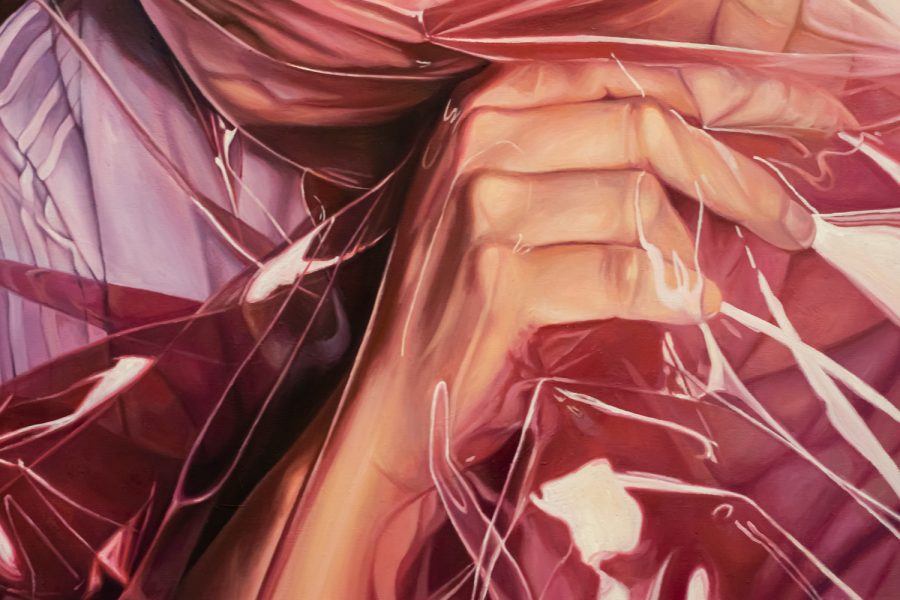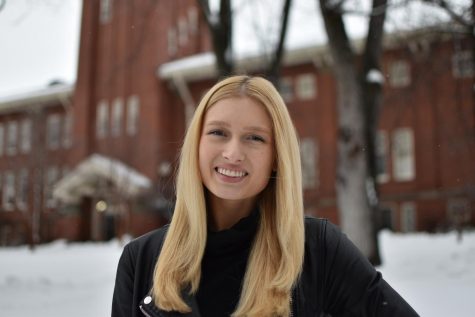Lost in Pullman: exhibition invites immersive experience
Art exhibition features works from the six MFA candidates; reception begins at 3 p.m.
Sarah Barnett’s paintings, including “Protection,” featured here, are often close-ups on large canvases. Her appreciation for the details in other’s paintings leads her to painting these close-ups so viewers can enjoy her details without having to search for them.
March 31, 2022
The Jordan Schnitzer Museum of Art will inaugurate its Master’s in Fine Arts Thesis Exhibition with a reception April 1. The reception runs from 4-6 p.m., with artist talks beginning at 3 p.m. The exhibition will remain in the museum through May 7.
The artist talks will be an informal tour of each artists’ work, MFA candidate Siri Stensberg said. Each artist will have roughly five minutes to talk about their work, and roughly five minutes to answer any questions.
The six MFA Thesis graduate candidates are Sarah Barnett, Jaime Durham, Autumn Hunnicutt, Meagan Marsh Pine, Seo Ryung Samantha Park and Stensberg.
The tradition of an MFA exhibition has existed for as long as the museum has, said Debby Stinson, Jordan Schnitzer Museum of Art marketing and public relations manager.
Though the art museum is a separate entity from the Department of Fine Arts, the two collaborate annually to display the MFA candidates’ works.
“This exhibition is the one time of year where we get to celebrate WSU, and we specifically get to celebrate WSU students,” Stinson said. “It’s really happy, it’s really fun, the work is gorgeous and if you really just want ‘the’ event of Mom’s Weekend, [this is] the event.”
Sarah Barnett
In the main hallway connecting the galleries, alongside the writing introducing the exhibition, hangs a painting from Barnett.
Barnett specializes in oil paintings. Her installation, “Foreign Body,” is a collection of nine paintings, two of which are matching halves of a large diptych.
Barnett said her art is influenced by a love of film and theater, specifically horror and sci-fi, of Baroque art and of human anatomy. Her paintings are defined by her use of realism, vivid colors and Baroque-esque qualities such as drapery and drama.
“Whether the subjects depicted are seen as being saved from – or in the aftermath of – a horrific tragedy,” Barnett wrote in her description of “Foreign Body,” “the lush color, delicate rendering and striking details tempt and challenge the onlooker to look deeper.”
While her works are largely open to interpretation, she said, common themes between them include the uncanny valley and the culture in America surrounding death and preservation.
Barnett can be found on Instagram at @sarahbarnettart.
Jaime Durham
The majority of the thesis exhibition’s textile pieces belong to Durham.
Her diligence is evident in the intricacies of her pieces. “Dipped, Pressed, and Woven” is a testimony to the creation process’s power in shaping art’s identity.
“I find immense value in making – in handling materials, observing them as they shift in form and color, and discovering what they can do,” Durham wrote in her artist statement. “I am finding connections between the slow, repetitive and rhythmic processes of printmaking, natural dyeing and weaving.”
Durham can be found on Instagram at @jaimedurham.
Autumn Hunnicutt
Inspired by her home in the Southwestern U.S., Hunnicutt’s installation, “Longing,” is characterized by bold uses of colors and depictions of organic life, with people, flowers and birds appearing in many of her works.
Accompanying “Longing” is a poem penned by Hunnicutt.
“I am the crow screaming love songs from across the road/the longing for the unknown,” she wrote. “I am the river that washes over heartache/reminding you that/you are not alone.”
Similar to her artwork, Hunnicutt’s poem evokes bold visuals and strong emotions, using references to nature to describe the feelings of being alive.
Influenced by ideas of family and familiarity, Hunnicutt’s art became a refuge for her as she endured graduate school during a pandemic, 1,000 miles from home.
Hunnicutt can be found on Instagram at @autumn_hunni or online at autumnhunnicuttart.com.
Meagan Marsh Pine
Drawing on the idea of nature, Marsh Pine’s “Green Space” is designed for the viewer to begin questioning their own understanding of landscape and reality, and the relationship between the two. It is an environment that is “tentatively familiar, but unstable,” according to their installation’s description.
“Green Space” is composed of two videos, three sculptures, three photographs and three paintings. The installation is a representation of Marsh Pine’s cross-disciplinary abilities.
The creation process for each medium was different, they said. The sculpture creation was freeform and organic, whereas the color field paintings were infinitely more structured.
“I was roughly thinking of myself as ‘artist as algorithm,’” Marsh Pine said. “Going and giving myself these sets of rules and following them very strictly.”
The installation aims to “glitch” the way viewers intake information about the world around them, they said. Much in the same way a computer processes information, so do we as humans. To “glitch” is to form a fault in the rendering, to push against the system that has predetermined the process.
Marsh Pine can be found on Instagram at @meaganmarshpine or online at meaganmarshpine.com.
Seo Ryung Samantha Park
“You Are the Only Sentence I Cannot Throw Away,” Park’s installation, is tied to her understanding of culture, identity and language as an immigrant and nonnative English speaker.
With a 400-inch long scroll as the centerpiece of the room, “You Are the Only Sentence I Cannot Throw Away” is rounded out with a looping video, a zine and Park’s personal diary.
“Each work reflects on the thoughts, feelings and memories of an immigrant navigating a new place,” Park wrote in her artist statement. “The illegibility of these pixelated texts and images touch upon feelings of linguistic alienation, confusion and turmoil that nonnative speakers experience.”
A beautiful blend of minimalism and maximalism, the vibrant pops of color and digital images highlight Park’s roots in illustration. The diorama plays on the idea that as words can be lost in translation, people and identities, too, can be.
Park can be found on Instagram at @seolilust or online at seoryungpark.com.
Siri Stensberg
In music, open and close harmony refer to the space between the notes in a chord. Open harmony exists when there’s more than an octave between the chord’s top and bottom notes – in other words, a greater space. Born from this idea of space and perspective, Stensberg’s “Open Harmony” is an immersive installation of light and sculpture.
“When I was working on the installation, I was thinking about the expansion of these objects in space, and inside the space. When I arrange them, I pay a lot of attention to the space in between elements,” Stensberg said. “I was thinking about the coordination of – orchestration of – the different materials, processes within this singular space.”
Stensberg’s preference for adaptable, upcycled materials matches her experimental style. She describes her creative process as being “really rooted in play.” The way different materials play together, the way lights play with shadows and reflections, the way she plays with the pieces to determine how they best communicate.
Some of the materials in use include pine needles and maple tree helicopters, which work to encourage the “Open Harmony” message of enjoying where you’re at and being mindful of the present. Instead of continually thinking about what’s happened or what’s to come, guests should hone their senses to the here and now, and see if they can find something in the often overlooked.
“I want people to get a little lost. I think with how complex it is and how immersive it is, I’m really asking people to stop and look and pay attention,” Stensberg said. “And that might be a little simple, but I think that it’s important.”
Stensberg can be found on Instagram at @siristensberg or online at siristensberg.com.
The museum’s hours are Tuesday through Friday 1-4 p.m. and Saturdays 10 a.m. to 4 p.m., with the exception of university holidays. More information can be found on the museum’s website.












